It’s been over two years now since we started Great Hires and since the beginning I have been bombarded with all the different ways to measure recruiting success. While many of them are interesting and good indicators of how efficient an organization is at sourcing and hiring top talent, in the end I have concluded that organizational leaders only need to focus on two strategic metrics: Quality of Hire and Candidate Experience. Everything else is details.

Let me explain, as I learned very early on in my career, the two primary outcomes a business leader is solving for are a) building organizational capacity and b) building the business. All other metrics are either efficiency metrics on measure input values. This is similar to baseball where there are several dozens of statistics collected on every player. As the book Moneyball pointed out, it is on-base percentage that is a significant predictor of wins and yet most experts focused on other statistics (e.g. slugging percentage) which did not correlate with the ultimate outcome objective of a baseball team.
Hiring and retaining great talent is clearly what a talent acquisition function is all about and directly responsible for building organizational capacity. If you were to pick a single measurement for how a TA organization contributes to building organizational capacity it would be Quality of Hire (QoH). While Cost-Per-Hire (CPH) and Time-to-Fill (TTF) provide good operational indicators for the effectiveness of the hiring team (similar to hits and batting average in baseball), the ultimate objective of recruiting is to bring on qualified personnel into the organization. Rarely will you hear organizations willing to compromise on QoH in order to drive down their CPH or TTF. It is only when they are looking to optimize the process while at a minimum keeping the outcome measurement fixed that hiring teams should then focus on CPH, TTF or any other recruiting efficiency metric.

Now, there is no industry standard for how to measure QoH since each organization is unique and there are multiple leading indicator metrics which can provide a reasonable proxy, but none is exact. Whether you believe the hiring manager satisfaction, one year retentions or staged (e.g. 2 weeks, 2 months, 1-year sometimes called First Year Quality) employee performance evaluation is right for your company, it is not an exact science. However, what matters is having consistent, multi-dimensional metrics which provide a holistic representation of hiring success.
By now you might agree that QoH is the most important measurement for recruiting, but you are probably asking yourself ‘Why would Candidate Experience be the other metric that matters?’. Very simply, in most cases it impacts business results. Keep in mind that 95% or more of the people that apply to your job won’t get hired and 75%-80% of the finalists that you brought in to interview won’t be joining your organization. If these candidates either buy or influence purchases for your company’s offerings, you might want them to still like you at the end of the process. There has been a lot of research that shows that both a negative and positive candidate experience directly impacts a company’s bottom line. Consumer-brands like Starbucks, Delta Airlines, Hilton Hotels and others have specific use cases detailing how their focus on improving their candidate experience had a positive business ROI.

And what about all those other commonly used metrics, do we just ignore them? Absolutely not. If you work in the talent acquisition function or are a hiring manager you definitely care, measure and prioritize factors like TTF and CPH. They make up the trinity of Cost, Quality & Time. And you optimize for all three. Always. As a TA leader you are solving for each of them by leveraging people, processes and tools. In addition, you need to be able to measure individual recruiter performance, and these input & process metrics provide good indicators to understand differentiated individual and department performance.
Similar to baseball, your primary objectives are to having a winning team that also makes money. In addition, while there are plenty of measurements which will help you “peel-the-onion” on where to focus and prioritize, you need to know where to start. When it comes to talent acquisition metrics it starts at the top and they are Quality of Hire and Candidate Experience. Focus on these first and use the other metrics to optimize the process or their inputs.
About the Author: Ray Tenenbaum is the founder of Great Hires, a recruiting technology startup offering a mobile-first Candidate Selection platform for both candidates and hiring team success. Ray has previously spent half of his career building Silicon Valley startups such as Red Answers and Adify (later sold to Cox Media); the other half of his career was spent in marketing and leadership roles at enterprise organizations including Procter & Gamble, Kraft, Booz & Co. and Intuit. Ray holds an MBA from the University of Michigan as well as a bachelor’s in chemical engineering from McGill University.
Follow Ray on Twitter @rayten or connect with him on LinkedIn.